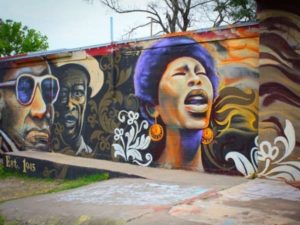
Austin’s historically Black East End District. Frank Mills.
African-Americans are leaving the city of Austin, Texas, in droves, according to a new study. The reason: They can no longer afford the homes.
Researchers at the Institute for Urban Policy Research & Analysis wanted to know why one of the country’s fastest-growing cities has experienced a steady decline in its African-American population in the last two decades.
From 2000 to 2010, the Black population declined by 5.4 percent, making Austin the only expanding city to see such a loss.
The demographic landscape is trending wealthier and whiter as a result.
An army of tech start-ups have descended upon the city, eager to take advantage of Texas’ lower cost of living and no state taxes. And festivals like South by Southwest and Austin City Limits have put the city on the map for aspiring artists and live-music aficionados.
The housing market has grown exponentially, and in typical fashion, gentrification is the byproduct.
Historically Black East Austin is a direct target, the report notes. Back in 1928, city councilmen declared the east-end community a “Negro District,” in a bid to “legally” segregate residents of the majority-white west side and Blacks living east of East Avenue and south of City Cemetery.
Municipal leaders eventually limited all Black schools, housing, parks and other “Black-only” amenities to the district, forcing families living in outside areas to relocate. Citizens transformed the town into a rich cultural enclave of African-inspired music, culinary traditions and arts. Today the district hosts a variety of blues and jazz venues, theater companies, visual arts and recording studios, and soul food restaurants.
“Decades later these very neighborhoods would become prime targets of gentrification,” wrote study author Eric Tang, assistant professor for the African and African Diaspora Studies Department. “Concentrated segregation followed by concentrated gentrification resulted in the massive displacement of African Americans from their historic communities.”
According to CNN, the median sales price of an East Austin home was $225,000 during the 2012-13 fiscal year. The average sales price two years later sharply increased to $345,000.
University of Texas’ institute surveyed 100 African-Americans who left the city between 1999 and present day. The respondents showed a diversity of ages (19 to 79) and incomes (between $12,000 and $200,000)
Tang writes, the report aimed to explore two topics:
“One, did African Americans choose to leave the city in pursuit of better opportunities elsewhere? Or were they compelled or forced to leave, and why? That is, were they “pushed out” by socioeconomic pressures, particularly the gentrification of historically African American neighborhoods and the simultaneous soaring cost of housing throughout the entire city?
And two, to what extent is the resettlement of African Americans to areas outside of Austin an extension of inequalities they have faced when living within the city?”
The No. 1 reason was elevated housing costs. Fifty-six (56) percent of respondents chose “unaffordable housing” as the cause for their migration.
The study includes direct quotes by several respondents. A 63-year-old man questioned the motive for waiting until recent years to renovate an area that could have used the makeover long ago.
“They didn’t want to redo East Austin when we were living in it. We saw what was happening in Austin. They were trying to get all the property in Austin they could get. City was taking and jacking up prices. The gentrification started settling in. Residents are sick to their stomach seeing what they see. They could have revitalized.”
The No. 2 reason for leaving was disappointment with the local education system. Twenty-four (24) percent chose “better schools.”
The report indicates the second leading reason was expected, as minors accounted for the majority of Blacks who vacated the city in the millennium’s first decade.
“One infers from this that African American heads of household based their decision to move out on the needs of their children, specifically on their educational needs,” Tang wrote.
The third-leading reason was institutional racism and a general feeling of unwelcomeness. Sixteen (16) percent of respondents named it as a problem.
“Austin has never been openly friendly to African Americans or allowed them to develop a significant economic enclave,” a woman, 46, said. “Austin has an antagonistic atmosphere to African Americans….Austin is unwelcoming. It’s a blatant slap in the face.”
Another former resident said he felt invisible in Austin.
“I feel like no one sees me. They don’t value that I’m there. They only notice me when there’s a problem. Thousands of Black kids who don’t get the same appreciation that a pet gets.”
Researchers found the out-migration of Blacks to surrounding cities had left former residents at a social, political, economical and health disadvantage, and Austin more economically and socially segregated than ever.
Tang warns of the future implications of a city so divided.
“Recent research also reveals that the more racially and economically segregated a metro area, the less economically mobile its entire population, particularly its younger residents.”


